Introduction
We grow nine varieties of grapes, and the Flame Seedless is one of our favorites. This popular and widely grown variety is known for its sweet, juicy, and flavorful fruit. The berries are seedless and have a reddish-purple color, a crisp texture, and thin skin. Viticulturists usually grow them in warm and dry climates, such as California, where they harvest them from late August to early September. You can eat fresh Flame Seedless grapes and make raisins, juices, and wines. Growing and caring for these grapes is relatively easy, making them an excellent choice for backyard gardeners who want to enjoy fresh, homegrown grapes.
Table of Content
A brief overview of Flame Seedless grapes
Flame Seedless grapes were first developed by David Ramming and Ron Tarailo at the United States Department of Agriculture (USDA) in California in the late 1960s. This variety was created by crossing two grape varieties: the Thompson Seedless and the Cardinal grapes. The goal of the breeding program was to create a new grape cultivar that would have the sweet and juicy flavor of the Thompson Seedless and the attractive red color of the Cardinal grape.
After many years of testing and evaluation, the Flame Seedless grape was released in 1973. Thanks to its desirable combination of flavor, color, and ease of cultivation, it quickly became popular among grape growers and consumers. Today, Flame Seedless grapes are one of the most widely grown grape varieties in California, and they are also grown in other warm and dry regions worldwide.
Advantages of growing grapes in a backyard garden
Growing grapes in a backyard garden have several advantages. First, grapes are easy to grow and maintain, requiring minimal care once established. Secondly, having a grapevine in your backyard can add beauty and aesthetic appeal to your garden.
Moreover, growing grapes in your backyard allows you access to fresh, ripe grapes free of harmful chemicals and pesticides. This means you can enjoy delicious, healthy fruit from your garden.
In hot summer, the grape canopy provides shade which can help us stay cool in hot weather and protect us from the sun’s harmful UV rays.
In addition, growing grapes can also provide a fun and educational activity for the whole family. It can be an excellent opportunity to teach children about gardening and the importance of fresh, healthy food.
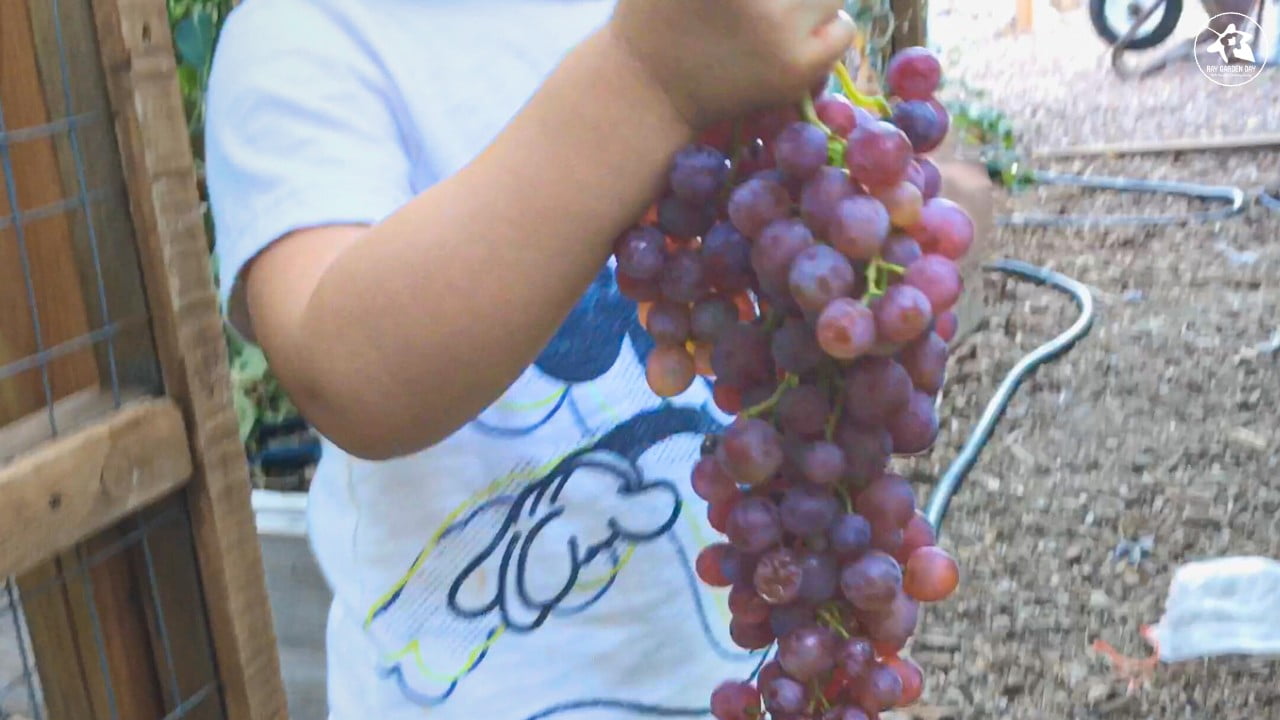
Finally, growing grapes can be a cost-effective way to enjoy fresh fruit. Instead of buying grapes from the grocery store, you can step into your backyard and pick them fresh off the vine.
Growing grapes in a backyard garden can be a rewarding and enjoyable experience with numerous benefits.

Choosing the Right Variety
Why Flame Seedless grapes are a good choice for backyard gardens
Flame Seedless grapes are a popular choice for backyard gardens for several reasons:
- Easy to Grow: Flame Seedless grapes are easy to grow and maintain, making them a great choice for novice gardeners. They tolerate various soil types and can be grown in most climates.
- High Yield: Flame Seedless grapes are known for their high yield, which means you can enjoy a bountiful harvest of delicious grapes from just one or two vines.
- Disease Resistant: Flame Seedless grapes are also relatively resistant to common grape diseases, such as powdery mildew and black rot. This means they require less maintenance and are less likely to be affected by pests and diseases.
- Delicious: Flame Seedless grapes are known for their sweet, juicy flavor, which makes them a popular choice for fresh eating, juicing, or making jams and jellies.
- Versatile: Flame Seedless grapes are versatile and can be used in various dishes, from salads and appetizers to desserts and baked goods.
Flame Seedless grapes are a great choice for backyard gardens due to their ease of growing, high yield, disease resistance, delicious flavor, and versatility. In addition, they are a low-maintenance fruit crop that can provide many benefits to home gardeners.
Other grape varieties to consider
There are many other types of grape varieties that you could consider, depending on your climate, soil type, and personal preferences. Here are a few examples:
Concord grapes are popular for making juice, jelly, and wine. They are hardy and adaptable, making them a good choice for colder climates.
Muscat grapes are known for their intense, sweet flavor and aroma. They are often used for making dessert wines and are best suited to warm, dry climates. I have a Golden Muscat cultivar, and while I still need to be more productive, the family appreciates its unique flavor from our small harvest.
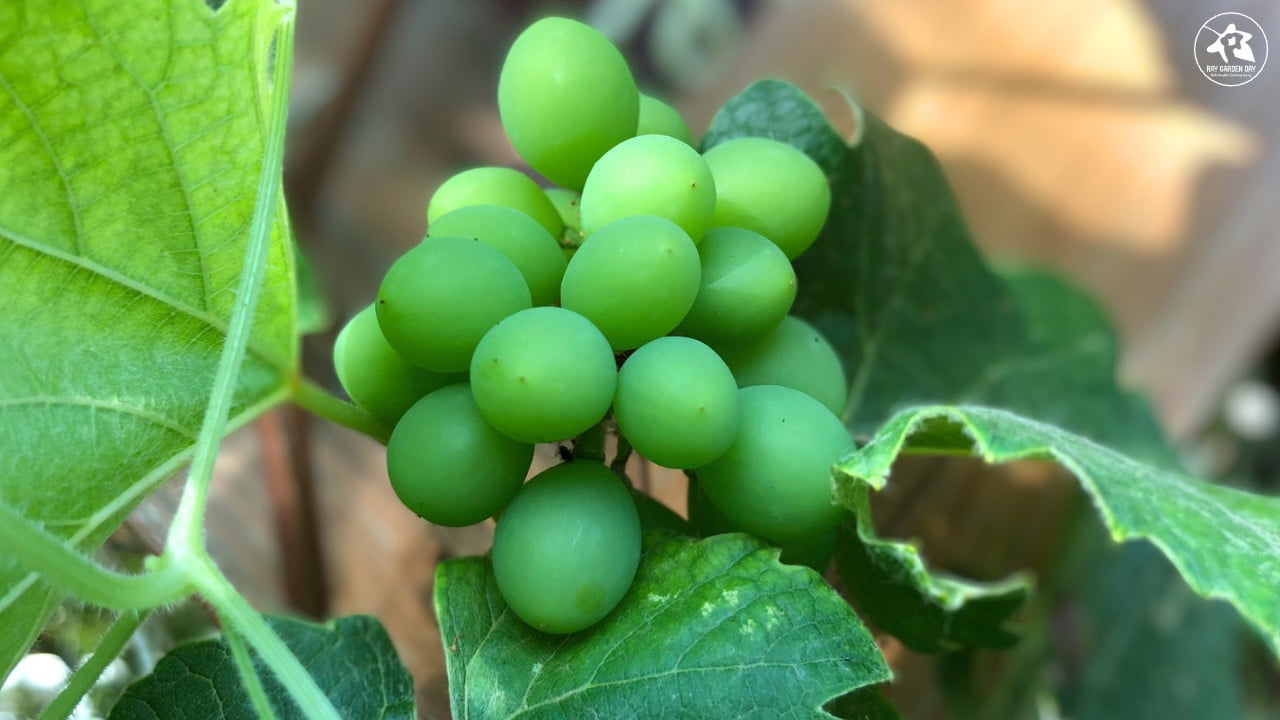
Thompson Seedless grapes are a popular variety for fresh eating and raisin production. They are easy to grow and are well-suited to hot, dry climates. We trained a Thompson seedless grapevine up our gazebo for added shade and visual interest to the garden and complemented the overall landscape design.
Cabernet Sauvignon grapes are famous for making red wine. They require a warm, sunny climate and well-drained soil.
Pinot Noir grapes are popular for making red wine. They are known for their complex, fruity flavors and are best suited to cooler climates with long, sunny growing seasons.
Chardonnay grapes are a popular variety for making white wine. They require a warm, sunny climate and are known for their rich, buttery flavor.
Crimson Seedless grapes are a seedless variety well-suited to warm, dry climates. They are often used for fresh eating and are known for their sweet, juicy flavor.
These are just a few grape varieties that you could consider. There are many other varieties, each with its unique flavor profile and growing requirements. Choosing a variety well-suited to your local climate and soil conditions is essential to ensure a successful harvest.
Plant nurseries stock grape varieties suited for your area because these plants are more likely to thrive in the local climate and soil conditions. In addition, nurseries typically select plants that are well-adapted to the local environment and can withstand the weather and other challenges that may be present in the area. Therefore, I recommend sourcing your young grape vines from local plant nurseries over buying them from big box stores.
Site Selection and Preparation
Ideal growing conditions for Flame Seedless grapes
Flame Seedless grapes are well-suited to backyard gardens in warm, dry climates. The ideal growing conditions for Flame Seedless grapes are as follows:
Flame Seedless grapes require a warm, dry climate to thrive. They are best suited to USDA hardiness zones 7-10, which have an average minimum temperature range of 0 to 40 degrees Fahrenheit.
Grapevines require plenty of sun exposure to produce sweet, flavorful fruit. Flame Seedless grapes need at least 6 hours of direct sunlight per day.
Flame Seedless grapes grow best in well-draining, loamy soil with a pH range of 6.0 to 6.5. The soil should be rich in organic matter and have good water-holding capacity.
Grapevines require regular watering, especially during the growing season. Flame Seedless grapes need consistent, moderate water but can be damaged by excessive moisture.
Grapevines require regular fertilization to promote healthy growth and fruit production. A balanced fertilizer with equal nitrogen, phosphorus, and potassium is recommended.
Grapevines require regular pruning to maintain shape and promote fruit production. Flame Seedless grapes should be pruned in late winter or early spring before new growth appears.
Choosing a suitable location in the backyard
When choosing a location in your backyard to plant Flame Seedless grapes, there are a few factors to consider:
Grapevines require plenty of sunlight to produce sweet, flavorful fruit. Choose a location that receives at least 6 hours of direct sunlight daily. A south-facing location is ideal as it gets the most sun exposure.
Grapevines prefer well-draining soil to avoid waterlogged roots. Choose a location with good drainage to prevent excess moisture.
Flame Seedless grapes require ample space to grow and spread out. Choose a location with enough room for the vines to grow up and out without being crowded by other plants. Our Flame Seedless vine is growing on a grape arbor with two side arms (cordons); the east-facing arm is 10 feet long while the opposite arm is 8 feet long – give it space.
Consider the microclimate of your backyard. A location sheltered from strong winds and frost pockets is ideal for growing Flame Seedless grapes.
Grapevines require consistent watering, especially during the growing season. Choose a location near a water source or where a hose can easily reach.
An optimum soil pH level for Flame Seedless grapes soil is 6.0 to 6.5. Test the soil in your chosen location to ensure it falls within this range. Our vine is thriving in the high 7s pH, a testament to how well Flame Seedless grapes can tolerate various soil types.
Soil preparation and amendments
Proper soil preparation and amendments are essential for growing healthy and productive Flame Seedless grapevines in your backyard garden. Follow these steps to prepare your soil and provide the necessary nutrients for your grapevines:
The first step in soil preparation is to test the pH level of your soil. Flame Seedless grapes prefer slightly acidic soil with a pH range of 6.0 to 6.5. You can test your soil pH using a soil test kit or by sending a soil sample to a local agricultural extension office.
Clear the planting area of any weeds, rocks, or other debris. Grapevines require ample space to grow and spread out, so choose a location that allows the vines to grow without being crowded.
Grapevines prefer well-draining soil. If your soil is heavy or compacted, you can improve drainage by adding organic matter such as compost or well-aged manure.
Depending on your soil test results, you may need to add soil amendments to provide the nutrients for your grapevines. Common soil amendments include:
- Nitrogen: Nitrogen is essential for plant growth and can be supplied through compost, manure, or a balanced fertilizer.
- Phosphorus: Phosphorus is necessary for root development and flower and fruit production. You can add phosphorus to your soil by adding bone meal or rock phosphate.
- Potassium: Potassium helps plants resist disease and stress. You can add potassium to your soil by adding wood ashes or a balanced fertilizer.
After planting your grapevines, apply a layer of organic mulch around the base of the plants. Mulch helps retain moisture in the soil and suppresses weed growth. Good choices for mulch include straw, leaves, or wood chips.
Planting Flame Seedless Grapevines
When to plant Flame Seedless grapevines
The best time to plant Flame Seedless grapevines is in the early spring, after the last frost date in your area. In most regions, this will be in late March or early April.
Planting in the spring allows the grapevines to establish a robust root system and get a good start before the hot summer months. It also reduces the risk of frost damage to young plants.
Before planting, make sure the soil is workable and not too wet. If the soil is too moist, wait until it dries out before planting.
If you live in an area with mild winters, you can also plant Flame Seedless grapevines in the fall, about 6-8 weeks before the first frost date. This allows the plants to establish their root system before going dormant for the winter.
Regardless of when you plant, choose healthy, disease-free plants from a reputable nursery or garden center.
How to plant Flame Seedless grapevines
Following these planting steps to help establish healthy Flame Seedless grapevines in your backyard:
- Choose a Site: Select a location in your backyard that receives full sun (at least 6 hours per day) and has well-draining soil. Frame Seedless grapevines also need good air circulation to reduce disease risk, so avoid planting in low-lying areas or near structures that block airflow.
- Prepare the Soil: Clear the planting area of any weeds or debris. Amend the soil for good drainage and fertility (see the soil preparation and amendment guide above).
- Dig a Hole: Dig a planting hole at least 2 feet deep and 2 feet wide. Space the holes about 6-8 feet apart for multiple grapevines for each plant.

Digging a hole to plant a grapevine is a straightforward process that involves choosing a suitable location, measuring the planting hole, digging the hole, amending the soil, planting the grapevine, and watering the grapevine. - Add Compost: Add a few shovelfuls of compost to each planting hole and mix it into the soil.
- Plant the Grapevines: Remove the Flame Seedless grapevine from its container and gently loosen the roots. Place the grapevine in the hole and backfill with soil, ensuring the graft union is at least 2 inches above the soil level. Tamp the soil down firmly around the base of the grapevine.
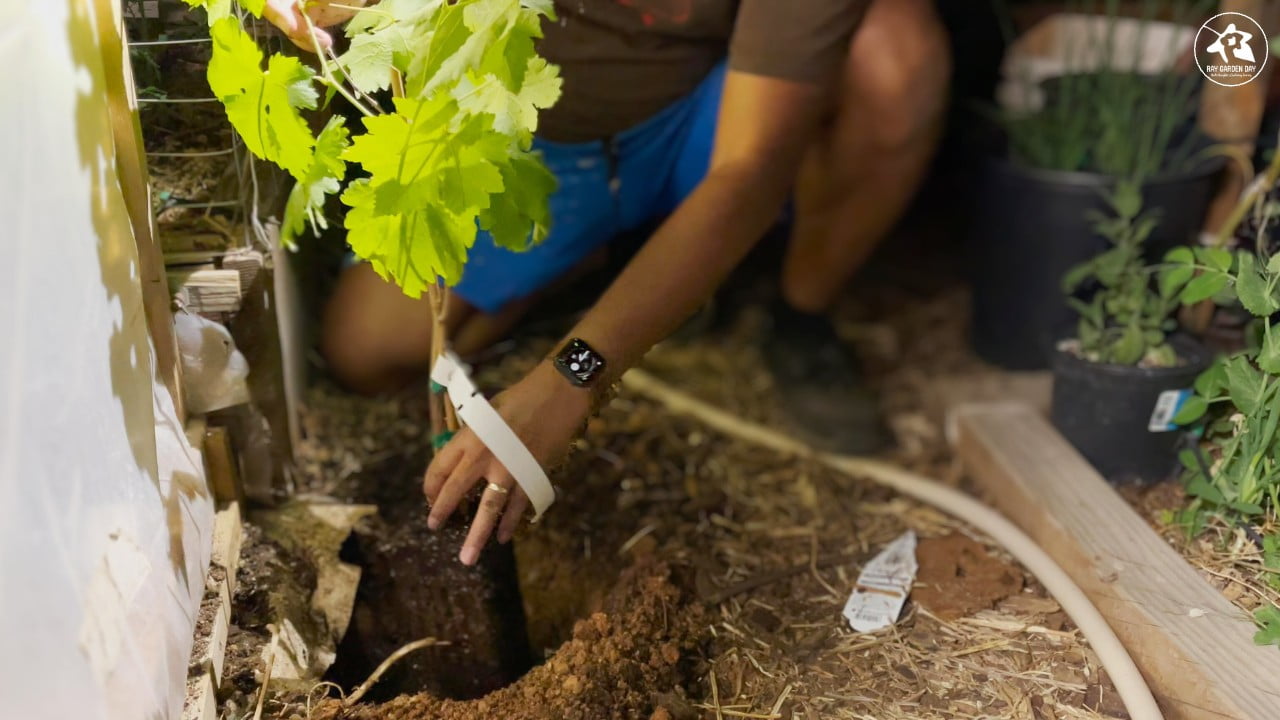
Place the Flame Seedline grapevine in the hole and backfill with soil, ensuring the graft union is at least 2 inches above the soil level. - Water: Water the grapevine thoroughly after planting to settle the soil around the roots. Water regularly throughout the growing season, keeping the ground evenly moist but not waterlogged.
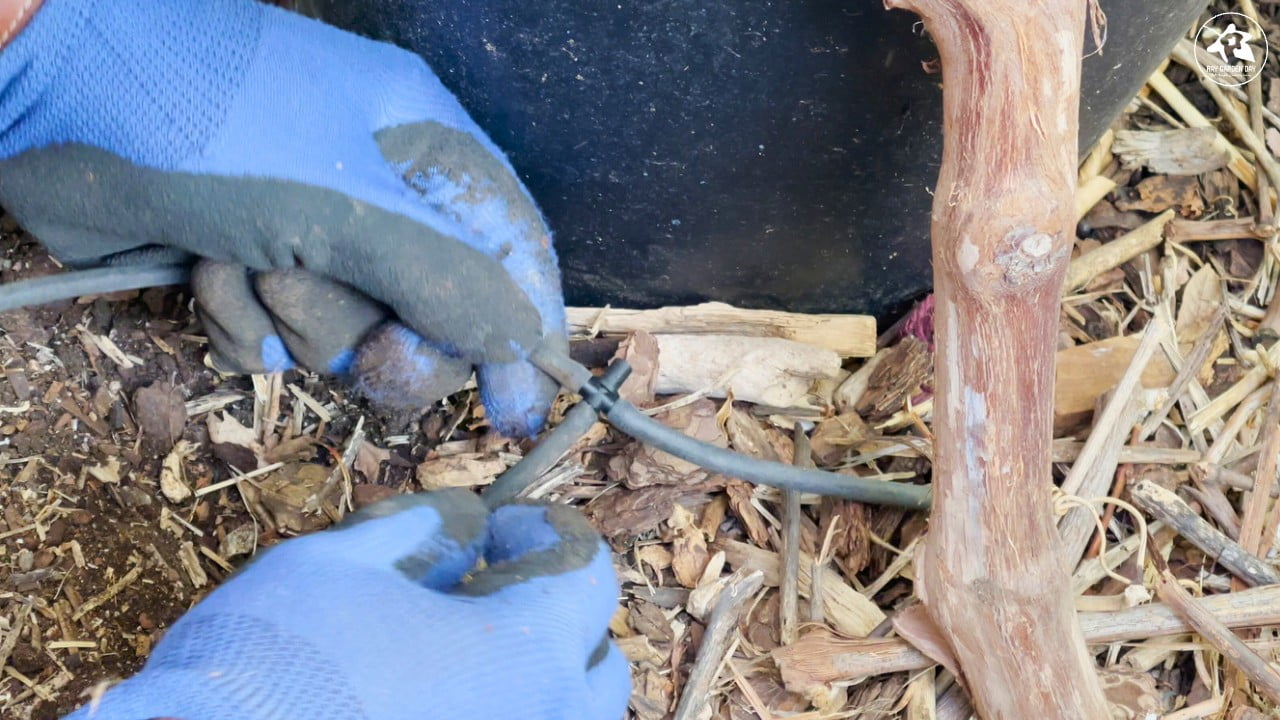
Drip irrigation is a method of watering plants by delivering water directly to their root zones in a slow, steady, and controlled manner through a network of tubes or pipes with emitters to ensure water efficiency, improved grape quality, and increased yield. - Train the Vine: As the grapevine grows, train it onto a trellis or support system. Secure the vines to the trellis with garden ties, ensuring it is adequately supported.
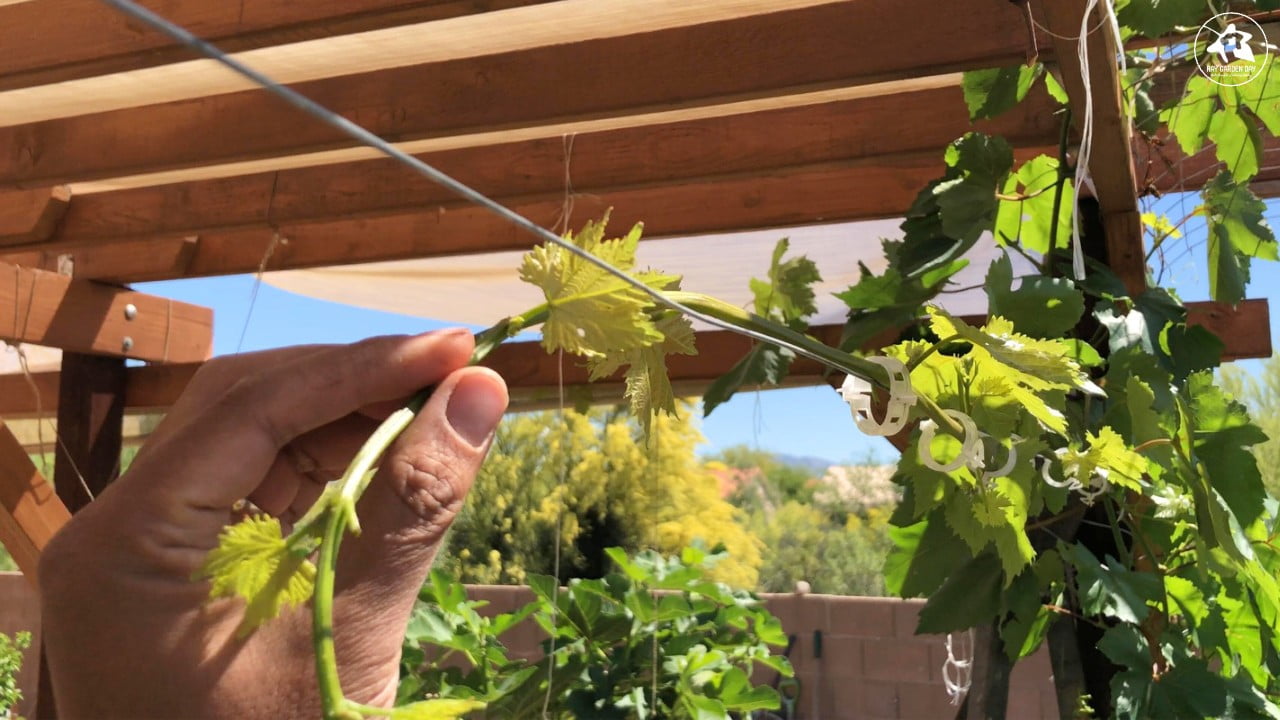
As the grapevine grows, train it onto a trellis or support system such as a wire with garden ties, ensuring it is adequately supported. - Prune: Prune the grapevine in late winter or early spring to remove any damaged or diseased wood and to shape the vine for optimal fruit production.
Training and trellising grapevines
Training and trellising Flame Seedless grapevines are essential to growing healthy and productive grapevines. To get started, here’s a brief guide:
Install a trellis system that suits your backyard space and grapevine needs. Some popular trellis systems include the Four Arm Kniffin system, T-trellis system, and Gable trellis system. Building a basic grape arbor or a DIY trellising system can be relatively easy and achievable for most backyard gardeners. Make sure the trellis is sturdy and can support the weight of the grapevines and fruit.
After planting a grapevine, select the strongest and healthiest shoot as the main leader. Trim away any other weaker shoots.
Train the main shoot up the trellis, tying them to the trellis with garden ties as they grow. You can also prune away lateral shoots or suckers extending from the main shoot, leaving only a few healthy buds.
Prune the grapevines annually in late winter or early spring to remove any dead, damaged, or diseased wood. Prune back the remaining shoots to control the vine’s growth and encourage fruit production.
As new shoots grow from the main trunk, train them along the trellis and secure them with garden ties. Keep the shoots spaced evenly and prune away any excess growth as needed.
Thin out excess fruit clusters to promote larger, healthier grapes. Leave only one or two clusters per shoot, and remove any small or damaged fruits.
Training and trellising your grapevines can seem intimidating, but there's something incredibly satisfying about watching your vines grow and flourish under your guidance. So don't be afraid to dive in and try - you'll be amazed at what you can achieve!

Watering, Fertilizing, and Pruning
Watering needs of Flame Seedless grapes
Proper watering is crucial for the growth and health of Flame Seedless grapevines. Here’s a guide to help you ensure your Flame Seedless grapevines receive adequate moisture and thrive in your backyard garden:
The water needs of a Flame Seedless grapevine depend on various factors such as climate, soil type, and plant age. Generally, a young Flame Seedless grapevine needs more frequent watering than mature vines. Mature Flame Seedless grapevines require about 1-2 inches of water per week from rainfall or irrigation.
Water the Flame Seedless grapevine deeply and infrequently. Watering deeply encourages the roots to grow deep into the soil and helps the vine withstand drought conditions. Water the Flame Seedless grapevine once a week or every two weeks, depending on the weather conditions and soil moisture.
Water the Flame Seedless grapevine early in the morning to allow the soil to dry out during the day. During the summer months in south-central Arizona, USA Zone 9a, the morning is between 4 AM and 8AM to avoid evaporation; watering in the afternoon or weather above 90 degrees may cause up to 50% of your water to be lost due to evaporation.
Drip irrigation or a soaker hose to water the Flame Seedless grapevine. These methods deliver water directly to the root zone and reduce water loss through evaporation. Avoid overhead watering, which can wet the foliage and increase the risk of fungal diseases.
Apply a layer of organic mulch, such as straw or leaves, around the base of the grapevines to retain moisture in the soil and suppress weed growth. This will also help regulate the soil temperature and improve soil fertility.
Check the soil moisture regularly by digging a small hole near the grapevine roots. If the soil is dry to a depth of 6 inches, it’s time to water the Flame Seedless grapevine.
Fertilizer requirements for grapevines
Proper fertilization is essential for Flame Seedless grapevines to produce healthy growth and abundant fruit. Here’s a step-by-step guide on fertilizing your grapevines:
Before applying any fertilizer, it’s essential to test your soil to determine its pH level and nutrient content. See the Soil Preparation and Amendments section above.
Based on the soil test results, choose a fertilizer appropriate for your Flame Seedless grapevine’s needs. Grapevines generally require a balanced fertilizer that contains equal parts nitrogen, phosphorus, and potassium (NPK). Additionally, grapevines require micronutrients such as magnesium, zinc, and iron, which can be found in specialized grape fertilizers.
Fertilize your Flame Seedless grapevine in the spring, just before the growing season begins. Avoid fertilizing in the fall or winter, which can encourage late-season growth that can be susceptible to cold damage.
Apply the fertilizer evenly around the base of the grapevine, not letting it come into contact with the trunk, stems, or foliage. Water the grapevine after applying the fertilizer to help it dissolve and move into the soil.
Organic fertilizers such as compost, well-rotted manure, and bone meal are also excellent options for fertilizing grapevines. These fertilizers release nutrients slowly over time, providing a stable source of nourishment for the Flame Seedless vine.
Monitor the growth and health of your Flame Seedless grapevine after fertilization, and adjust the application rate or frequency as needed. Over-fertilization can lead to excessive growth and reduced fruit quality, while under-fertilization can result in stunted growth and poor fruit production.
Pruning and training Flame Seedless grapevines for optimal growth and yield
Pruning and training are essential practices in grapevine cultivation to achieve optimal growth and yield. Pruning involves the removal of unnecessary or unwanted parts of the vine, such as shoots, leaves, and old wood, while training refers to shaping and directing the vine’s growth.
The goals of pruning and training are to promote healthy growth, increase fruit quality, and maximize yield. The vine can focus its resources on producing high-quality fruit by removing excess shoots and leaves. In addition, training helps to keep the vine’s canopy open and exposed to sunlight, which is essential for photosynthesis and ripening.
Several pruning and training methods are used in grapevine cultivation, including spur, cane, and Guyot prune. Each method has advantages and disadvantages and may suit different grape varieties and growing conditions.
My excellent resource covers everything you need to know for optimal grapevine growth and yield. From selecting the proper pruning method to mastering the perfect timing, this guide has got you covered with clear and actionable steps. Whether you’re a beginner or an experienced grape grower, this guide is a must-read. See grapevine pruning: how to get an excellent fruit crop guide.
Pest and Disease Management
Common pests and diseases of grapevines
Like all grapevines, Flame Seedless grapevines are susceptible to various pests and diseases that can affect their growth and yield. Here is an overview of some of the most common pests and diseases that can affect Flame Seedless grapevines:
A tiny aphid-like insect that feeds on the roots and leaves of grapevines, causing stunted growth, leaf curling, and decreased yield.
A tiny, green insect that feeds on grapevine leaves, causing yellowing and wilting.
The larvae of Grapeleaf skeletonizer feed on the grapevine foliage as soon as they hatch. See my guide on How to get rid of grapeleaf skeletonizer.
Dune beetles are scarab beetles found in North America that feed on feed on grape berries.
A moth whose larvae feed on grape berries, causing damage and reduced yield.
A fungal disease that affects grapevines’ leaves and fruit, causing a powdery white coating and decreased yield.
A fungal disease that affects grapevines’ leaves and fruit, causing yellowing and decreased yield.
A fungal disease that affects grapevines’ fruit, causing rotting and reduced yield.
A fungal disease that affects grapevines’ leaves and fruit, causing black spots and decreased yield.
A fungal disease that affects grapevines’ leaves and canes, causing spotting and reduced yield.
To prevent and manage these pests and diseases, have the right maintenance plan that includes best cultural practices, such as proper pruning and canopy management, and fungicides and insecticides when necessary. Early detection and prompt treatment are also essential for minimizing damage and ensuring optimal growth and yield of Flame Seedless grapevines.
Organic and chemical pest control options
Organic and chemical pest control options are available for managing pests and diseases in Flame Seedless grapevines.
Here are some options for both organic and chemical pest control:
Organic Pest Control
An organic insecticide that works by suffocating and repelling pests.
A natural insecticide that works by breaking down the outer layer of soft-bodied insects like aphids and leafhoppers.
A natural bacterial insecticide that targets the larvae of many insects, including grape berry moth.
A natural fungicide that prevents and controls powdery mildew and other fungal diseases.
A natural fungicide that prevents and controls downy mildew and other fungal diseases.
Organic pest control options may require more frequent applications but are generally considered safer for the environment and human health.
Whether you want to use organic pest control or chemical, the choice of pest control method depends on your preferences, growing conditions, and specific pest and disease pressures.
Harvesting and Enjoying Flame Seedless Grapes
How to know when grapes are ready to harvest
Knowing when to harvest Flame Seedless grapes is crucial for achieving the best flavor, sweetness, and texture. Here is a short guide on how to know when Flame Seedless grapes are ready to harvest:
Flame Seedless grapes turn from green to pink to deep red as they ripen. Once the grapes are uniformly deep red, they are usually ready to harvest.
Taste a few grapes and check for sweetness. Flame Seedless grapes are typically sweet with a sugar content of around 17-20% when fully ripe.
Squeeze a few grapes gently and check for firmness. Ripe Flame Seedless grapes should be plump and firm but not too hard.
Flame Seedless grapes are seedless, so if you see seeds, the grapes are not fully ripe.
Grapes should be harvested with a short section of stem attached. The stem should be green, flexible, and not too woody.
Harvesting should be done on dry days when the grapes are dry. Wet grapes are prone to fungal diseases and can spoil quickly in storage.
Harvesting Flame Seedless grapes at the right time ensures they have peak flavor and sweetness and helps prevent overripe and underripe grapes. Once harvested, the grapes can be stored in a cool, dry place or consumed immediately for the best flavor.
Proper harvesting techniques
Harvesting Flame Seedless grapes requires careful attention to detail and proper techniques to ensure that the grapes are picked at peak ripeness and quality. Here is a brief guide on proper harvesting techniques:
Use sharp pruning shears to cut the grapes from the vine. This will prevent damaging the grape cluster or leaving parts of the stem attached to the grape.
Harvesting Flame Seedless grapes in the morning when the grapes are cool, and the highest sugar content is ideal. Wineries often pick grapes at night or in the early morning when the temperatures are cooler to help preserve the quality of the grapes.
Handle the grapes gently to avoid damaging them. Avoid crushing or squeezing the grapes, as this can lead to spoilage.
Harvest the whole grape cluster at once rather than picking individual grapes. This ensures that the grapes are at a consistent ripeness level and minimizes damage to the vine.
After harvesting, sort the grapes by size and ripeness level. This makes removing any damaged or underripe grapes easier before storage or processing.
Store Flame Seedless grapes in a cool, dry place or refrigerate them if necessary. Avoid storing the grapes with other fruits or vegetables that give off ethylene gas, such as apples, bananas, and peaches, as this can cause the grapes to spoil more quickly.
Recipes and ideas for using fresh Flame Seedless grapes
Flame Seedless grapes are delicious and versatile fruits that can be used in a variety of recipes. Here are some ideas for using fresh Flame Seedless grapes:
Combine fresh Flame Seedless grapes with other fruits such as melon, berries, and kiwi for a refreshing and colorful fruit salad.
Puree fresh Flame Seedless grapes with sugar and lemon juice, then freeze in an ice cream maker for a delicious and refreshing grape sorbet.
Combine diced Flame Seedless grapes with chopped onion, jalapeno, cilantro, and lime juice for a sweet and spicy salsa that pairs well with grilled meats or tortilla chips.
Blend fresh Flame Seedless grapes with yogurt, honey, and ice for a creamy and sweet smoothie.
Arrange fresh Flame Seedless grapes on a cheese board with various cheeses, crackers, nuts, and cured meats for an elegant and tasty appetizer.
Roast fresh Flame Seedless grapes with olive oil, salt, and rosemary, then spread on toasted bread with goat cheese for a savory and sweet crostini.
Combine chopped chicken, grapes, celery, and almonds with a dressing of mayonnaise, yogurt, and lemon juice for a light and flavorful chicken salad.
These are just a few ideas for using fresh Flame Seedless grapes. Get creative and experiment using them in other recipes, such as jams, pies, and cocktails!
Conclusion and Final Thoughts
Here’s a recap of key points to successfully grow Flame Seedless grapes in a home backyard:
- Choose a sunny location with well-draining soil.
- Provide support for the vines to grow on, such as a trellis or arbor.
- Prune the vines in late winter or early spring to promote new growth.
- Water the vines regularly, especially during hot, dry weather.
- Fertilize the vines in the spring and summer with a balanced fertilizer.
- Control pests and diseases using organic control methods.
- Harvest the grapes when they are ripe and handle them carefully.
- Enjoy the grapes fresh or use them in a variety of recipes.
If you’re considering growing grapes in your backyard garden, Flame Seedless grapes are a great choice! Their sweet, juicy flavor and versatility in the kitchen make them delicious and rewarding fruit to grow. Take your time with the process – with some basic knowledge and care, anyone can successfully grow grapes in their own backyard. So why not try it and enjoy the fruits of your labor? You may be surprised by how much you love having your own fresh grapes to enjoy!
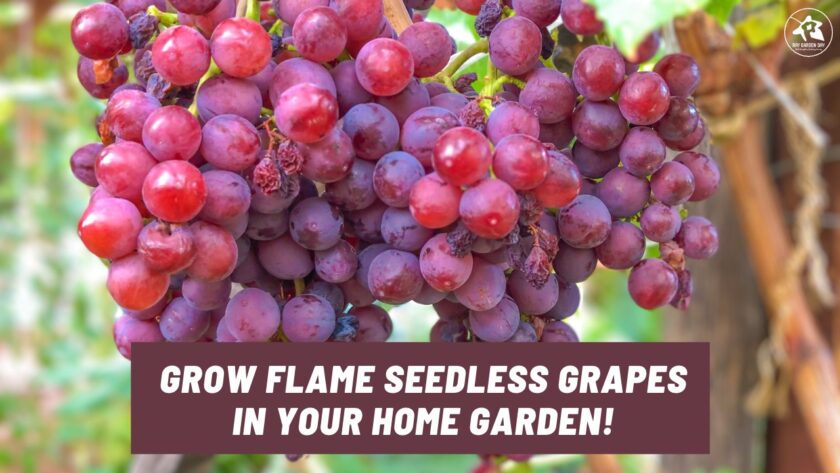

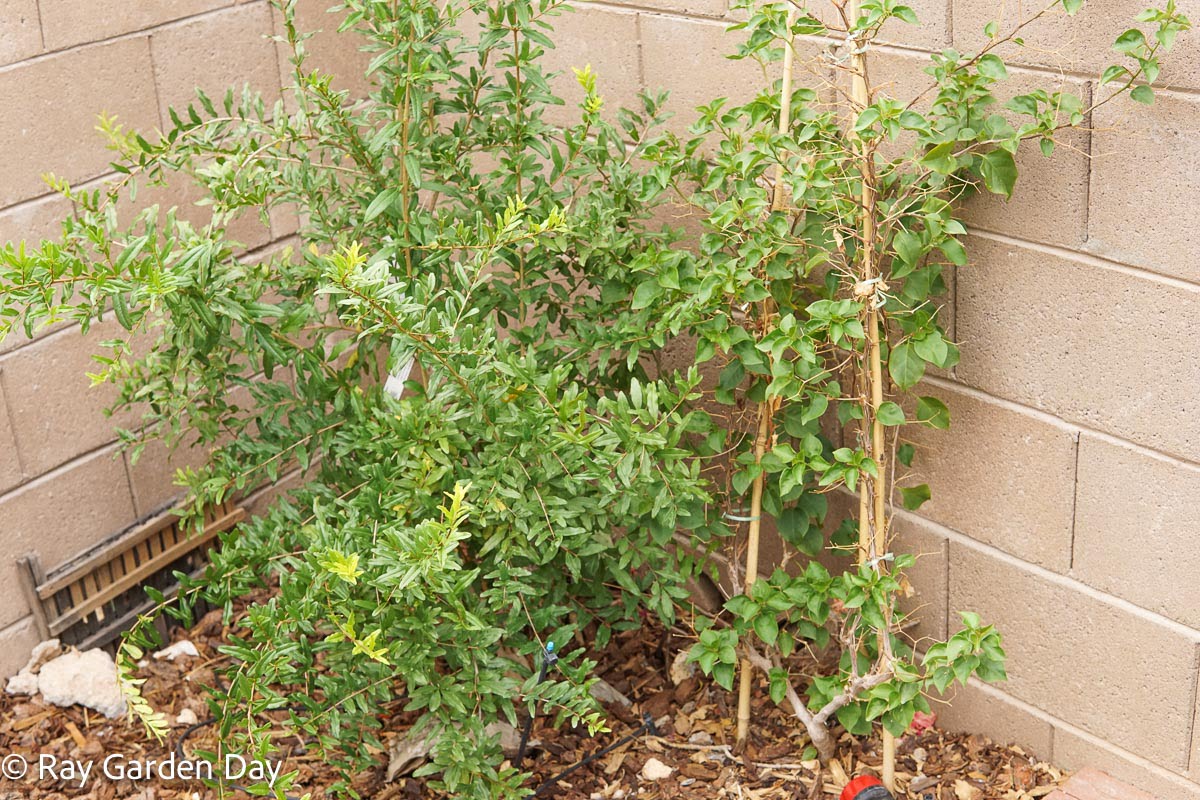


… [Trackback]
[…] Read More: raygardenday.com/garden/fruits/grape/flame-seedless-grape/ultimate-guide-to-growing-and-harvesting-flame-seedless-grapes-in-your-home-garden/ […]
Pomegranates are truly a delightful fruit, and it sounds like you’re managing your harvest with a thoughtful approach.
Wishing you continued success with your gardening endeavors and the most flavorful pomegranates!